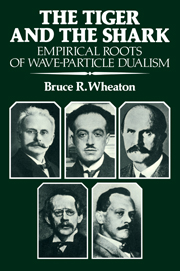Book contents
- Frontmatter
- Contents
- Foreword by Thomas S. Kuhn
- Preface
- Notes on sources
- 1 Introduction
- Part I The introduction of temporal discontinuity, 1896–1905
- Part II Ionization and the recognition of paradox, 1906–1910
- Part III Seeking an electrodynamic solution, 1907–1912
- Part IV Interference of x-rays and the corroboration of paradox, 1912–1922
- Part V The conceptual origins of wave–particle dualism, 1921–1925
- 10 Synthesis of matter and light
- Epilogue: The tiger and the shark
- Bibliography
- Index
10 - Synthesis of matter and light
Published online by Cambridge University Press: 04 August 2010
- Frontmatter
- Contents
- Foreword by Thomas S. Kuhn
- Preface
- Notes on sources
- 1 Introduction
- Part I The introduction of temporal discontinuity, 1896–1905
- Part II Ionization and the recognition of paradox, 1906–1910
- Part III Seeking an electrodynamic solution, 1907–1912
- Part IV Interference of x-rays and the corroboration of paradox, 1912–1922
- Part V The conceptual origins of wave–particle dualism, 1921–1925
- 10 Synthesis of matter and light
- Epilogue: The tiger and the shark
- Bibliography
- Index
Summary
A group of electrons that traverses a sufficiently small aperture will exhibit diffraction effects.
It is not entirely surprising that the earliest reaffirmation of the dualism inherent in radiation came neither from Britain nor Germany. There the issues had been recognized, discussed, and dismissed over the preceding twenty years. And American research traditions were largely derivative of German and British models; Duane and Millikan had both studied under Planck, and Richardson did research with Thomson in Cambridge. It took an outsider to these traditions to raise the issues in a way that began to convince others.
That process began in France. Maurice and Louis de Broglie were, by any standards, unusual physicists. Amateurs in an age of professionals, possessing a confidence born of noble status, working on experiments that had only the meagerest precedent in their homeland, they were not as firmly bound by the predispositions that prevented physicists of other nations from directly assessing the spatially localized lightquantum.
Their conversion was real. Maurice had once been convinced that x-rays and γ-rays fit neatly into the electromagnetic spectrum. In his discussion, La nature des rayons de Röntgen in 1915, there was no thought that x-rays might be anything other than periodic waves. As late as May 1920, he spoke freely of x-ray “wavelengths” and discussed the optical fluorescence that results from degradation of x-ray “frequency.” But late in 1920 he reviewed the new evidence accumulated at high x-ray frequencies. There he hinted at unspecified difficulties in the orthodox wave interpretation of x-rays.
- Type
- Chapter
- Information
- The Tiger and the SharkEmpirical Roots of Wave-Particle Dualism, pp. 263 - 301Publisher: Cambridge University PressPrint publication year: 1983



